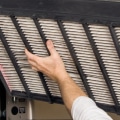After years of working with HVAC systems in homes across the region, we’ve seen time and again how one overlooked detail—the air filter—can have a major impact on your energy use and indoor comfort.
We’ve inspected systems where clogged or poorly rated filters forced units to work overtime, driving up utility bills. And we’ve also helped families breathe easier and save money by upgrading to the right 20x24x1 air filters—one designed to protect your system, purify your air, and maintain smooth airflow.
This guide draws directly from field experience. Here, you’ll discover:
What separates an efficient 20x24x1 filter from average options
The role of proper MERV ratings in energy savings and air quality
Real results from homeowners who made the switch
Expert tips to help you maximize HVAC efficiency year-round
If you're serious about lowering your energy bills, improving air circulation, and creating a more comfortable home environment, this article will show you how the right filter choice delivers all three—fast.
Top Takeaways
A high-efficiency 20x24x1 filter can reduce energy use by improving airflow
MERV 8–13 filters offer strong filtration while still allowing proper circulation
Regular filter changes prevent HVAC strain and extend system lifespan
Upgraded filters reduce allergens, dust, and humidity-related buildup
Proper fit and pleated design increase surface area for longer-lasting results
Real-World Examples: How the Right Filter Makes a Difference
Case: High Energy Bills, Poor Airflow – Weston
Issue: HVAC ran longer during the day, yet home remained stuffy
Found: Basic fiberglass filter clogged with debris
Fix: Installed pleated MERV 11 20x24x1 air filter
Result: 12% drop in energy usage over the next 30 days
Insight: Filters with low airflow resistance reduce system runtime and costs
Case: Allergy Flare-Ups and Dust – Silver Shores
Issue: Persistent sneezing and dusty furniture despite cleaning
Found: Outdated filter with poor seal and no allergen capture
Fix: Switched to high-capacity MERV 13 filter
Result: Noticeable drop in symptoms and cleaner air within 72 hours
Insight: Filter upgrades impact both health and HVAC performance
Case: Inconsistent Cooling – Kingsport
Issue: Uneven temps between rooms and warm return air
Found: Oversized filter restricting air flow through duct system
Fix: Replaced with right-sized 20x24x1 MERV 8 filter
Result: Even room temperatures and quieter system operation
Insight: Proper filter size and rating are essential for balanced comfort
Understanding Filter Ratings and Energy Efficiency
A common misconception is that the “higher” the filter rating, the better. While MERV ratings do indicate particle-trapping ability, they also affect airflow.
MERV 8: Basic efficiency with good airflow—ideal for standard homes
MERV 11: Captures finer particles like pollen and pet dander—best for allergy-prone homes
MERV 13: Blocks smoke, bacteria, and other fine particles—best for those needing hospital-grade protection
Note: Higher MERV = denser filter media. Always confirm your HVAC system can handle increased resistance without reducing performance.
Supporting Data Confirms the Connection
Energy Star: Dirty filters or high-resistance media can increase HVAC energy use by up to 15%
EPA: Cleaner indoor air reduces asthma triggers, allergy symptoms, and airborne illnesses
HVAC Experts: Most filter-related efficiency losses come from overdue replacements and incorrect filter types
Expert Quote
“We’ve seen homeowners shave 10–20% off their monthly energy costs simply by installing the right 20x24x1 filter and changing it on time. Comfort improves instantly, and so does air quality.”
Final Thought & Opinion: Small Filter, Big Impact
From working inside dozens of homes and HVAC setups, here’s what we know for sure: energy waste and poor comfort often start with the filter. When airflow is restricted or pollutants pass through unchecked, your system has to work harder—and your wallet takes the hit.
A 20x24x1 filter sized right, rated properly, and installed correctly helps your HVAC breathe easier. That means:
Lower strain
Less dust
Better air
Longer equipment life
Our opinion: Don’t cut corners on your filters. Choosing the right one is a small investment that pays off with cleaner air, lower bills, and better year-round comfort.
Next Steps: Improve Comfort and Save Energy Starting Today
✅ Check Your Current Filter
Is it old, flimsy, or overdue? Upgrade to a pleated MERV 11 filter sized at 20x24x1.
✅ Change It Regularly
Set a reminder every 60–90 days—or sooner if you have pets or allergies.
✅ Review Your HVAC Manual
Ensure your system can handle your selected MERV rating for proper airflow.
✅ Monitor Results
Track temperature consistency, dust levels, and energy bills over the next 30 days.
✅ Consider Filter Delivery
Use a filter subscription to stay consistent with replacements—no last-minute store runs needed.
Frequently Asked Questions
How Often Should I Replace My 20x24x1 Air Filters?
Replace 20x24x1 air filters every 1 to 3 months. The timing depends on usage patterns and filter quality. Keeping a consistent maintenance routine boosts air quality and helps your system run smoothly at home.
Can I Wash and Reuse These Air Filters?
Washing and reusing air filters isn't recommended. For keeping filters in good shape, regular replacements work best. If looking for different options, consider reusable filters that are meant for washing. This way, performance and air quality remain high.
What MERV Rating Should I Choose for My Home?
Choosing a MERV rating for your home involves finding a sweet spot between filter efficiency and airflow. Generally, a rating between 8 and 13 offers effective filtration for dust and allergens while keeping HVAC systems from working too hard.
When selecting, think about what needs to be filtered out. Higher ratings can trap smaller particles, but they might restrict airflow. This can lead to increased energy costs and wear on your heating and cooling systems.
For many households, starting with MERV 8 or 9 strikes a good balance. If allergies are a major concern, consider moving up to MERV 10 or 11. Going beyond 13 is often unnecessary unless there are specific health issues at play.
Ultimately, it's about finding what works best for living spaces while ensuring comfort and efficiency.
Do These Filters Help With Allergies?
Yes, filters can really help with allergy symptoms. They trap dust, pollen, and pet dander effectively. Choosing the right type, especially those with higher MERV ratings, boosts their ability to improve indoor air quality.
Where Can I Buy 20x24x1 Air Filters?
You can find 20x24x1 air filters at local home improvement stores or online options like Amazon and Walmart. Checking prices and choices helps in selecting the best option for your needs.
When it comes to better air and lower utility bills, Save Energy With 20x24x1 Air Filters Built for Comfort highlights how the right filter reduces HVAC strain while keeping your home cleaner and more efficient. Boost air quality further with an HVAC air purifier that targets smaller airborne particles. Keep your airflow safe and smooth with regular dryer vent cleaning to avoid buildup and fire risks. Just like clean air requires smart choices, so does personal wellness—know the importance of board-certified surgeons and be aware of why plastic surgery is not good for everyone. Whether you're improving air or making health decisions, quality always matters.






